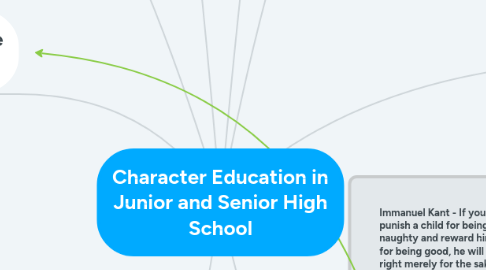
1. Method
1.1. The Virtues Project
1.1.1. One virtue will be explicitly taught 20-30 mins daily for one week using The Virtues Project which is used by the entire tribal council
1.1.1.1. January virtue 1 hour every other day
1.1.2. These virtues will be taught in groups no larger than 8 students
1.1.2.1. Depending on schedule was altered to whole class with 14 students
1.1.3. Students will receive visual cards with their name, date and virtue they demonstrated with a verbal affirmation that they've demonstrated the virtue for the week.
1.1.3.1. By November, we recognized any virtue demonstrated even if it wasn't that particular week's virtue as a way to reinforce the language of virtues and show virtues in practice
1.1.4. Students will self monitor the virtues they display, their TA's can assist them in writing the virtue onto their card
1.1.4.1. Not all TA's participated . 3/3 actually recognized virtues in their students who participated in study started to recognize students by the end
2. Hypothesis
2.1. Students who receive Virtue/Character education will demonstrate more empathy and undesirable behaviours will decrease.
2.2. Behaviours that will see a marked decrease will be: disrespectful talking out/back in class, on task behaviours,and ability to self-regulate
3. Literature Review
3.1. What is Character Education?
3.1.1. Explicit delivery of mediated learning experiences designed to promote prosocial attitudes and behaviour that support the development of social competences and a cooperative disposition
3.1.2. Character Education(CE) seeks to foster an improvement in numerous behavioural domains such as pro-social skills, self-control, and academic achievement and corresponding reduction in negative behaviours
3.1.3. Respect, responsibility, trustworthiness, fairness, caring and honesty
3.2. Why use Character Education?
3.2.1. Schools using CE report significantly more positive behaviours and less substance use, violent behaviours and voluntary sexual activity
3.2.2. CE is associated with lower absenteeism and fewer suspensions and retentions
3.2.3. Schools using CE saw marked improvements in all outcomes over the control schools
3.2.4. Aim is for students to be able to internalize the values inherent in the tradition and culture of society through CE
3.2.5. Develop resiliency
3.3. Restorative Processes
3.3.1. Students are enhanced through facilitation by knowing adults or more competent peers
3.3.2. Engaging in dialogue for the purpose of shame management, problem solving, conflict resolution
3.4. Virtue Program
3.4.1. 1 virtue per week, on short weeks this was extended or when we had closures do to cold weather or funerals in the community -9 virtues were taught, compassion, respect, caring, consideration, helpfulness, generosity, thankfulness, trustworthiness, responsibility
3.4.2. utilized the 5 steps, one-one talks with students who struggled and acts of restoration
3.4.3. Students with attendance issues (and all students) were greeted each day with a hand shake, fist bump, pat on the shoulder, hug if requested, or just verbally
3.4.3.1. "said I am so glad to see you today. I have missed you. If makes me so much happier when you're here, or it's so much more fun when you're here, a positive affirmation
3.4.3.2. Brought extra lunch to share with the ones who were hungry
3.4.3.2.1. Cooked oatmeal or a warm breakfast as often as we could afford during period 1 to encourage arriving on time
3.4.3.3. Found warm clothes at Value Village or donated by family/friends and shoes for those who needed
4. Results
4.1. 1. self report showed decrease as did teacher
4.2. 2. self report some improvement, teacher some no significant change
4.3. 3. some positive changes from both teacher and student reports
5. Participants
5.1. 3 students from the special education program who have intellectual disabilities
5.1.1. Female age 12, traumatic brain injury, severe difficulties with receptive and expressive language, executive functioning (cognitive flexibility, working memory, emotional control, planning, etc). Student demonstrates difficulty in solving problems without the use of inappropriate language or physical harm to other students - attendance too poor to stay in study
5.1.1.1. Male age 11, grade 6, new to school, qualifies as high cost, extremely active, needs further assessment for ADHD, severe difficulties with receptive and expressive language (lots of general statements difficulty finding specific vocabulary -there, there, stuff, etc. working memory, emotional control, planning, cause and effect, consequences, - physical aggression, verbal outbursts, wandering if not monitored, actions are everyone else's fault, does not accept responsibility disrupts learning of others
5.1.2. Male student age 13, with an intellectual disability. All areas affected such as expressive and receptive language, language fluency, calculation, math fluency, working memory, executive functioning. Student has demonstrated an explosive and violent temper as well as verbal abuse towards students and staff. -update, has become withdrawn after removal from mother, then foster mother died
5.1.2.1. Male age 12, grade 7 qualified as high cost, poor attendance last year, moved repeatedly - previous teacher warned about stealing and fire settings. Very low academically, k-1 range in all subjects, extremely low receptive and expressive language, cannot understand consequences of actions, poor planning, very active, requires numerous visuals and cues to attend, uses wobble stool while in class, helps a bit. Becomes angry but if he likes you will give you a hug and apologize but will repeat the same action even if talked to
5.1.3. Male student age 13 with an intellectual disability. Severe difficulties with receptive and expressive language, executive functioning, working memory, calculation and math fluency. Student demonstrates hyperactivity, poor impulse control, teases peers and is uses defiance and avoidance when asked to to complete academic tasks or participate in activities. - student was moved from group home to another placement- transferred schools
6. Instruments
6.1. Reflection Journal
6.1.1. To be completed at least 3 times weekly
6.2. Student Behaviour Self Assessment - rating scale
6.2.1. To be completed monthly
6.3. Teacher Behaviour Assessment - checklist/rating of frequency
6.3.1. To be completed monthly

